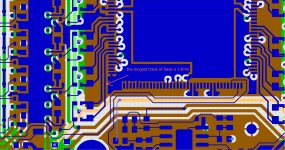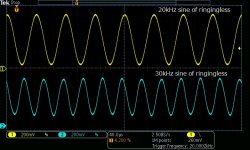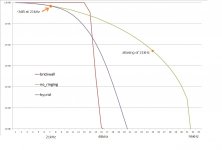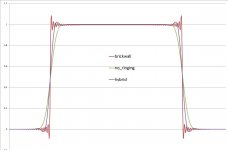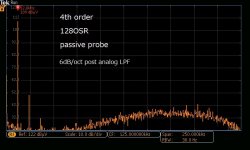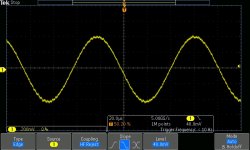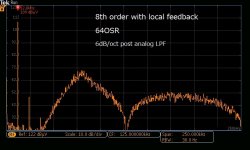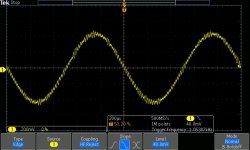Actually it's standard procedure in controlled listening tests. Small amplitude differences, say 0.2 dB to 1 dB, are often perceived as a difference in sound quality rather than volume.
That is true when testing people off the street. There is no published evidence showing it is necessary for methodically trained long-term skilled listeners.
Last edited:
Have you seen any evidence to the contrary?
In any case, if you are looking for some obscure effect that may or may not be audible, you don't want ANY audible differences that are unrelated to whatever you are testing. Maybe trained listeners are better at recognizing amplitude differences as amplitude differences, but even if that were the case, those differences would still be unacceptable. (Unless, of course, you believe that methodically trained long-term skilled listeners are incapable of perceiving amplitude differences that people off the street can perceive, but that would seem somewhat absurd.)
In any case, if you are looking for some obscure effect that may or may not be audible, you don't want ANY audible differences that are unrelated to whatever you are testing. Maybe trained listeners are better at recognizing amplitude differences as amplitude differences, but even if that were the case, those differences would still be unacceptable. (Unless, of course, you believe that methodically trained long-term skilled listeners are incapable of perceiving amplitude differences that people off the street can perceive, but that would seem somewhat absurd.)
Last edited:
Expectation bias is a possible cause for such differences, or unintended non-verbal communication when you do a single-blind test, or simple level differences when the levels are not matched within 0.1 dB. Have you done any tests that exclude these basic issues and if so, how?
By the way, when comparing digital filters or sigma-delta algorithms, it is fairly easy to add a circuit that randomly chooses a filter/SDM and only indicates afterwards what you were listening to. With some non-volatile memory you can even use that unknown filter or sigma-delta over several listening sessions and switch off the equipment in between.
Regarding phase issues, the question is not whether they are audible, but how bad they have to be to become audible. To give an extreme example, with DSP techniques and lots of memory you could make a filter with perfectly flat steady-state sine wave response that delays the bass by a few milliseconds and the treble by an hour. I don't think anyone would believe that to be inaudible.
That last part was funny, must say!
Good extreme example, but no clue about the right answer.
HQPlayer Desktop or Embedded can't switch on the fly (needs playback be stopped, settings changed and re-initialisation).
With the Pro version, on the top of my head 10 times more expensive, you can just convert and save some versions to disk then randomize and repeat playback and skip the files with a remote.
Then just write down what you hear, and bob's your uncle!
For verification of changes I always use my colleague, who doesn't expect a thing.
True story, not being funny at all.
But that isn't needed most of the time: the differences are way too easy to pick out to need a strict approach.
I mean, speakers as well as dacs tend to sound so different from one another that the hardest part is to translate that to better or worse and be convinced of that judgment call.
What's the call on a dac that has great soundstage but tends more towards a nasty (revealing or harsh?) treble versus one that seems to have lost it's natural weight but with sweet highs, it's just the voices seem so small. We all know that's at least the case with swapping some gear.
Many times these are the sort changes that you have to make an opinion about. I rather don't and let the matching with the rest of the set do the magic.
Sometimes it's all there, all is good and whatever music you put on, it all flows. It's just good on low level listening as well as at high levels, the imaging is good, you can hear what everybody is doing, you just want to play more music, you forget about the technicalities and enjoy the lyrics, the musicians doing their thing, all is good.
Most importantly rhythm is there and every recording sounds different from the other. So you know the electronics and speakers are disappearing.
When that happens you can change the small things like filtering etc. If that's not the state the set is in, then it's rather hard and a more scientific approach is needed because the changes look like differences but non conclusive in any meaningful musical way.
But in principality, double blind etc is the safest way.
OK, so I should have called it subject-expectancy effect or observer-expectancy effect rather than expectation bias.
Probably not. Please don't misunderstand my position. I know very well that many people experience errors of cognition when doing listening comparisons. I would also agree that untrained listeners can be easily fooled by Fletcher-Munson effects. Unfortunately, some of these things have never been studied very well, if at all (by very well, I mean in light of what is now known in the fields of cognitive psychology and perceptual testing). Highly technically trained and experienced listeners haven't been studied at all that I am aware of. Why would they be, most people would not fall into that category anyway and we only need to know what is close enough for about 95% of the population. Of course, it is also very easy for true Experimenter Bias to occur, but that would be a risk affecting AES psychoacoustics researchers, not their test subjects.
Last edited:
Well, this was a good technical thread, now dominated by opinions about what a few people think sound good.
Well, this was a good technical thread, now dominated by opinions about what a few people think sound good.
And other opinions from people who think what other people think sounds good is useless noise. It's all opinion in some way or other, us being human and all.
There are thousands of other on topic threads to pollute with arguments about the sound of op-amps or claims that ignore the duality of the time and frequency domain, etc. I am not talking about you specifically Mark. Why does it seem like every technical discussion here has to devolve into “I think this sounds bad and my way is right”?
The way recording and mastering engineers are trained has changed drastically. It used to be an apprentice system at the best of the big studios which takes many years to learn. Now people learn what they do from internet forums and buy soundcards online to get started. The big studios are mostly gone. Technology and economics cause what they do. It will take a long time to get to great digital audio at affordable prices. Maybe another 20-years, especially given there is no money for public research. What people do learn is often kept as trade secret information. What is to be expected, then?
Very true. Then again, what to expect from technology and economics when people nowadays, in general, mostly listen to music on their tv. Or own some mini stereo with eeny miny speakers, or on busy streets with 50 dollar headphones and low res streaming?
Or maybe that was already what you were saying (not just big studio's disappearing)?
Strangely, the consumer part of digital audio has made great progress. Foobar, Roon, HQPlayer, good choice in online streaming services as well as great interfaces on all known devices, cross platform!
It seems if you're an audio engineer or with (in?) the industry, it's our task to get rid of those low-fi devices like mediocre sound bars etc so people at least have the chance of recognizing good sound quality. Otherwise it's of no direct economic use to have great studio's.
It does make one wonder why e.g. dynamic range on an lp is often better than on cd while technically this shouldn't be the case. All produced for loud environments like cars and walking on the street, or to overcome the distortions of the weeny sets.
Man oh man. We've got a job to do..
Well, this was a good technical thread, now dominated by opinions about what a few people think sound good.
Might look that way, maybe it isn't.
To me this is where people exchange ideas and everybody has the right to his own opinion.
Not the place to push people into corners, even though opinions can be strongly made and differ greatly.
There's bound to be someone who only wants his strong believe to be taken as the only true way.
But that's just annoying.
Feynman said "science is the belief in the ignorance of experts".
I believe we're all ignorant ;-)
Why does it seem like every technical discussion here has to devolve into “I think this sounds bad and my way is right”?
I have a lot to say, not always on point, rather lengthy and diluted at times.
Others are happily different. I enjoy the time and work someone put into his or her opinion or conviction.
If there's an opinion be sure, if I disagree, to say so and back it up with my evidence or just an anekdote.
Most of the times I read, and make an opinion about it or add to discussion or follow up with a question because it's interesting stuff.
The best thread is one that evolves and provides opinions based on evidence.
Sadly in audio this evidence can range from clear BS to clear cut scientific data and all be advocated as "true".
Based on my own experiences, been a full time job over 20 years now, I am convinced besides hard scientific evidence there needs to be wiggle room because, well, let's just say that's what science proves also: we're people and have to make interpretations, we make mistakes and also in gathering and evaluating scientific data we are subject to bias etc.
All in all: nobody is absolutely right. There's many ways to Rome and don't try to convince people they should accept your scientific data (or ultimately your version of the cherry picking everybody more or less does, intentionally or not), nobody has to do anything here, we're all free.
I don't think A-B test is meaningful because you can't wash away what you hear. The first impression of A has some bias to the next music(B), though a trained listener can erase the feeling. It takes two or three months for me to determine which one is better. If I don't want to change the setting-A after two months listening, it's OK for me to be with the setting-A. Comfortable or not is the point where no technical background(DSM order, FIR length, and ringing ) have meaning: emotional judgment. I can't explain why I prefer A to B since likeness is likeness; I have no words about my subjective preference. What I can say is technical issues; I can't hear the phase difference between harmonics but can hear noise floor fructuation, the smaller, the better.
Exactly and rightfully so; you do what you can do and has meaning. There's not much more one can do 🙂
xx3stksm, about the oscillations: could those be parasitic Colpitts-oscillations due to the lack of base stopper resistors? You mainly have them with long FIRDACs, presumably these also have the longest wires to the differential pair bases.
Another question altogether: what kind of interpolation filter did you use?
Another question altogether: what kind of interpolation filter did you use?
Thank you for your advice. I also tried a base stopper resistor, though FPGA I/O has already internal 75-ohm resistor. Additional 100-ohm had almost no effect to stop the oscillation. Parasitic capacitance between the collector and the ground is minimal because of ground plane void. The longest track from FPGA to the base of transistor is 13mm(the 1st pic). The best solution to the problem is an emitter resistor like Q5 and Q6(the 2nd pic), which is still a temporary one.
I have three interpolation filters to do oversampling up to x64 or x128: brick-wall, no ringing, and hybrid. Brick-wall has well-known ringing, which is usually regarded as a fault but has no technical background about the guilty. It becomes wrong only if the ringing results in overflow like the 3rd pic. More than 1 ends up overflow and causes audible degradation in SQ. Some attenuation(3dB) quickly eliminates a chance of overflow, and you have automatic prevention if your DAC is 1bit DSM because it must have at least 6dB attenuation.
Another way to be free from overflow is done by ringing less filter, which never has overflow because ringing less one always has the max amplitude at DC. Whatever waveform the input is, no overflow exists. The advantage is a trade-off between frequency response. Ringing less family can't have steep attenuation, which is possible only by brick-wall. If your sampling frequency is 48kHz, I don't think ringing less is practical because of large aliasing. I recommend 96kHz sampling even if your target is 20kHz bandwidth. The 5th pic is the reason. Aliasing of no_ringing can be acceptable since the max aliasing of 21kHz caused by 96kHz (96-21=75kHz) has 46dB attenuation(the 5th pic).
The 6th pic is real waveform of ringing less filter, where you have almost the same one as the original. Even if you have 3dB attenuation, the max amplitude of brick-wall without overflow must be smaller than ringing less. From such a viewpoint, ringing less with some droop at HF has meaning. Many of us already have aging droop. Hybrid is in-between, neither steep nor ringing free but moderate one is sometimes useful.
I have three interpolation filters to do oversampling up to x64 or x128: brick-wall, no ringing, and hybrid. Brick-wall has well-known ringing, which is usually regarded as a fault but has no technical background about the guilty. It becomes wrong only if the ringing results in overflow like the 3rd pic. More than 1 ends up overflow and causes audible degradation in SQ. Some attenuation(3dB) quickly eliminates a chance of overflow, and you have automatic prevention if your DAC is 1bit DSM because it must have at least 6dB attenuation.
Another way to be free from overflow is done by ringing less filter, which never has overflow because ringing less one always has the max amplitude at DC. Whatever waveform the input is, no overflow exists. The advantage is a trade-off between frequency response. Ringing less family can't have steep attenuation, which is possible only by brick-wall. If your sampling frequency is 48kHz, I don't think ringing less is practical because of large aliasing. I recommend 96kHz sampling even if your target is 20kHz bandwidth. The 5th pic is the reason. Aliasing of no_ringing can be acceptable since the max aliasing of 21kHz caused by 96kHz (96-21=75kHz) has 46dB attenuation(the 5th pic).
The 6th pic is real waveform of ringing less filter, where you have almost the same one as the original. Even if you have 3dB attenuation, the max amplitude of brick-wall without overflow must be smaller than ringing less. From such a viewpoint, ringing less with some droop at HF has meaning. Many of us already have aging droop. Hybrid is in-between, neither steep nor ringing free but moderate one is sometimes useful.
Attachments
Hi XX3STKSM, I was wondering if you went ahead with this and e.g. fixed the oscillations you experienced, or any other update on this great project?
Greetings and have a great sunday!
Greetings and have a great sunday!
Somebody have an experience with passive Zanden style multi RLC notch filter + Sin(x)/x emulating?
coincidence
Hi,mterbekke. I'm still on the way to the goal(120dB N and 120dB THD)🙂. I have just received my 2nd version PCB yesterday, which has both 36-taps analog FIR and 48-taps. If the PCB is free from oscillation, I can be a winner who has more than 117dB THD+N with 1bitDSM. Win or fail is probably 50% from my experience.
Digital domain(DS modulator) has almost fixed. The best solution for my hardware is a little bit different from normal 1bitDSM, where large OSR(256 or 512) and high order DSM(7th or 8th) are usually used. My optimum setup is 128OSR and 4th order DSM(1st pic and 2nd). The reason is that you can't utilize low quantization noise which is brought by high order DSM with 64OSR, because residual noise caused by DA conversion is the dominating factor in the analog domain. Quantization noise by high order DSM is far below analog one. The lower doesn't mean a better result. Small quantization noise in the in-band ends up large quantization one in the out of band(3rd pic and 4th). I don't like high order analog post-LPF (24dB/oct or more) used in SACD, though you can ignore out of band noise. My analog post-LPF is usually 6dB/oct. 128OSR with 4th order DSM can bring you small quantization noise both in the in-band and out of band.
Hi,mterbekke. I'm still on the way to the goal(120dB N and 120dB THD)🙂. I have just received my 2nd version PCB yesterday, which has both 36-taps analog FIR and 48-taps. If the PCB is free from oscillation, I can be a winner who has more than 117dB THD+N with 1bitDSM. Win or fail is probably 50% from my experience.
Digital domain(DS modulator) has almost fixed. The best solution for my hardware is a little bit different from normal 1bitDSM, where large OSR(256 or 512) and high order DSM(7th or 8th) are usually used. My optimum setup is 128OSR and 4th order DSM(1st pic and 2nd). The reason is that you can't utilize low quantization noise which is brought by high order DSM with 64OSR, because residual noise caused by DA conversion is the dominating factor in the analog domain. Quantization noise by high order DSM is far below analog one. The lower doesn't mean a better result. Small quantization noise in the in-band ends up large quantization one in the out of band(3rd pic and 4th). I don't like high order analog post-LPF (24dB/oct or more) used in SACD, though you can ignore out of band noise. My analog post-LPF is usually 6dB/oct. 128OSR with 4th order DSM can bring you small quantization noise both in the in-band and out of band.
Attachments
Hi,mterbekke. I'm still on the way to the goal(120dB N and 120dB THD)🙂. I have just received my 2nd version PCB yesterday, which has both 36-taps analog FIR and 48-taps. If the PCB is free from oscillation, I can be a winner who has more than 117dB THD+N with 1bitDSM. Win or fail is probably 50% from my experience.
Digital domain(DS modulator) has almost fixed. The best solution for my hardware is a little bit different from normal 1bitDSM, where large OSR(256 or 512) and high order DSM(7th or 8th) are usually used. My optimum setup is 128OSR and 4th order DSM(1st pic and 2nd). The reason is that you can't utilize low quantization noise which is brought by high order DSM with 64OSR, because residual noise caused by DA conversion is the dominating factor in the analog domain. Quantization noise by high order DSM is far below analog one. The lower doesn't mean a better result. Small quantization noise in the in-band ends up large quantization one in the out of band(3rd pic and 4th). I don't like high order analog post-LPF (24dB/oct or more) used in SACD, though you can ignore out of band noise. My analog post-LPF is usually 6dB/oct. 128OSR with 4th order DSM can bring you small quantization noise both in the in-band and out of band.
Hi xx3stksm,
120dB thd+N is not an easy goal. Imho the thd is the easiest part, the noise a lot harder.
Great to see you push forward!
Are the design choices you make based on listening preferences solely or partly or not at all?
I might need to clarify.
My experience on one hand has been that the lower order DSM's always sound a bit "fuller", but also a bit sloppy.
On the other hand, a high order DSM might make the sound too thin, as if too much micro details pop up and make the whole thing sound artificial.
Experience has also been that used architecture, type of hardware (cmos, cml etc) play a big role and can result in being hardly able to hear these traits of the DSM order or to be just plainly annoyed by hearing them all the time.
If I remember correctly you said you didn't listen to help decide in some of the design choices that one needs to make (correct me if I'm wrong), how do you decide on what's acceptable performance if you don't, or if you did listen: how did you get convinced about using this DSM order etc?
Btw I always enjoy the intermodulation distortion tests with a 1 bit dac, those really stand out and make many multi bit dac's look state of the old-art;-)
Curious how things progress, good luck!
P.S. what Tek is that?
Somebody have an experience with passive Zanden style multi RLC notch filter + Sin(x)/x emulating?
Sorry Zoran, I don't. Really passive, isn't that asking for problems like extreme dependency on input and output impedances etc, or do you mean something else?
- Home
- Source & Line
- Digital Line Level
- My no DAC project, FPGA and transistors
